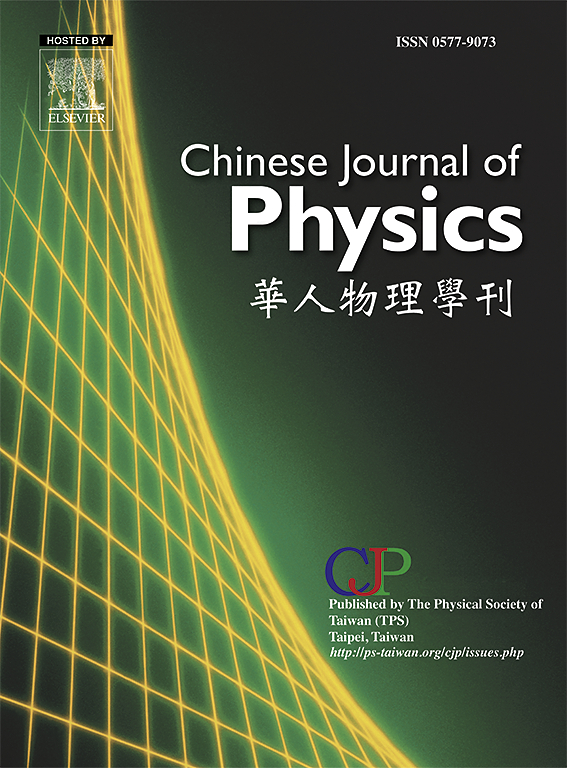Terahertz characteristics of Mg-doped CuCrO2 and its application to 2π phase modulators with high tunable capability
IF 4.6
2区 物理与天体物理
Q1 PHYSICS, MULTIDISCIPLINARY
引用次数: 0
Abstract
We have conducted a detailed characterization of the optical properties of Mg-doped CuCrO2 (CuCrO2: Mg) in the terahertz (THz) frequency range. By utilizing CuCrO2: Mg as transparent electrodes, we have demonstrated the approach for developing high-transmittance and low-operative-voltage THz phase shifters by electrically tuning liquid crystals (LCs). Unlike traditional indium-tin-oxide thin films, we have applied 600 nm-thick CuCrO2: Mg thin films as transparent electrodes, and our results show that this material has great potential for THz photonics. Specifically, the transparent electrode with THz transmission of ∼92 % reveals the feasibility of CuCrO2: Mg as a suitable material for THz photonics applications. The phase shifter scheme, which employs a ∼2.2 mm-thick cell, achieves a THz transmittance ∼70 %, a phase shift of more than 2π at 1.0 THz can be achieved even for low driving voltages of 14 V(rms). By considering the figure of merit (FOM) of LCs phase modulators defined in this work, the device based on CuCrO2: Mg thin film shows an FOM value of 17.99; much higher than previously reported values. These results suggest that functional electrodes based on CuCrO2: Mg thin films are promising components of THz and 6 G devices.

掺镁CuCrO2的太赫兹特性及其在高可调谐2π相位调制器中的应用
我们对掺Mg的CuCrO2 (CuCrO2: Mg)在太赫兹(THz)频率范围内的光学特性进行了详细的表征。通过使用CuCrO2: Mg作为透明电极,我们展示了通过电调谐液晶(lc)开发高透射率和低工作电压太赫兹移相器的方法。与传统的铟锡氧化物薄膜不同,我们采用了600 nm厚的CuCrO2: Mg薄膜作为透明电极,我们的结果表明这种材料具有很大的太赫兹光子学潜力。具体来说,太赫兹透射率为~ 92%的透明电极揭示了CuCrO2: Mg作为太赫兹光子学应用的合适材料的可行性。相移器方案采用了~ 2.2 mm厚的电池,实现了~ 70%的太赫兹透射率,即使在14 V(rms)的低驱动电压下,也可以在1.0太赫兹下实现超过2π的相移。考虑到本文定义的lc相位调制器的优点值(FOM), CuCrO2: Mg薄膜器件的FOM值为17.99;远高于之前报道的数值。这些结果表明,基于CuCrO2: Mg薄膜的功能电极是太赫兹和6g器件的有前途的组件。
本文章由计算机程序翻译,如有差异,请以英文原文为准。
求助全文
约1分钟内获得全文
求助全文
来源期刊

Chinese Journal of Physics
物理-物理:综合
CiteScore
8.50
自引率
10.00%
发文量
361
审稿时长
44 days
期刊介绍:
The Chinese Journal of Physics publishes important advances in various branches in physics, including statistical and biophysical physics, condensed matter physics, atomic/molecular physics, optics, particle physics and nuclear physics.
The editors welcome manuscripts on:
-General Physics: Statistical and Quantum Mechanics, etc.-
Gravitation and Astrophysics-
Elementary Particles and Fields-
Nuclear Physics-
Atomic, Molecular, and Optical Physics-
Quantum Information and Quantum Computation-
Fluid Dynamics, Nonlinear Dynamics, Chaos, and Complex Networks-
Plasma and Beam Physics-
Condensed Matter: Structure, etc.-
Condensed Matter: Electronic Properties, etc.-
Polymer, Soft Matter, Biological, and Interdisciplinary Physics.
CJP publishes regular research papers, feature articles and review papers.
 求助内容:
求助内容: 应助结果提醒方式:
应助结果提醒方式:


